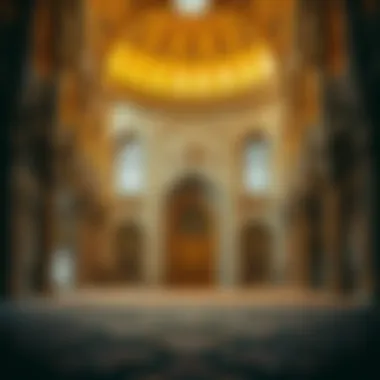Prayer Times and Observances at Jumeirah Mosque


Intro
Nestled in the heart of Dubai, the Jumeirah Mosque stands as a beacon of architectural beauty and spiritual significance. This mosque is one of the few in the United Arab Emirates that opens its doors to non-Muslims, making it a cultural bridge between diverse communities. Understanding the mosque's prayer times offers insight into the cadence of life here and illuminates the religious practices that shape daily routines for both residents and tourists.
The prayer times at Jumeirah Mosque are more than just numbers; they symbolize a rich cultural tapestry woven into the fabric of Dubai's society. Attending prayers, or even observing them from a distance, provides a glimpse into a lifestyle that values faith, community, and tradition. This guide aims to dissect the importance of these prayer times, contextualize them within the broader landscape of Islamic observance, and highlight the role of Jumeirah Mosque in fostering community connection.
By navigating through the nuances surrounding prayer times and community practices, this article will not only serve as a compass for visitors but also showcase opportunities for those looking to invest or engage more deeply with this vibrant locale.
Foreword to Jumeirah Mosque
Jumeirah Mosque stands as one of the most iconic landmarks in Dubai. The mosque is not just a place of worship; it represents a blend of cultural heritage and modernity, making it an essential part of the city's identity. It serves as a bridge between the local Muslim community and international visitors, facilitating a deeper understanding of Islamic traditions and values.
Historical Context
The history of Jumeirah Mosque dates back to 1976. It was built in the traditional Fatimid architectural style, which was prevalent in North Africa during the 10th to 12th centuries. This choice of design reflects a respect for Islamic heritage while also showcasing the architectural aspirations of Dubai during its growth phase.
The mosque has witnessed significant social changes in the region. Initially serving a modest local congregation, it now welcomes thousands of tourists and residents alike. This evolution mirrors Dubai's rapid modernization, showcasing how a traditional site has adapted to the vibrant community around it. Today, Jumeirah Mosque not only serves religious functions but also plays an educational role, particularly through its guided tours and open-door policy.
Architectural Significance
Architecturally, Jumeirah Mosque is strikingly beautiful, distinguished by its white stone finish and intricate detailing. The mosque is circular in design, adorned with two large minarets, creating a visually appealing silhouette against the city skyline. The craftsmanship is evident in the masonry, calligraphy, and decorative elements that reflect an appreciation for both function and art.
Beyond its aesthetic appeal, the mosque has been designed to accommodate larger congregations, with a capacity to hold up to 1,200 worshippers. This makes it not just a place of personal prayers but a hub for community gatherings during significant religious events. The layout encourages inclusivity and participation, underscoring its role as a landmark of unity among diverse groups in the bustling city of Dubai.
Role in the Community
The community role of Jumeirah Mosque extends far beyond its spiritual services. The mosque provides a platform for inter-faith dialogue, inviting visitors to engage in discussions about Islam and its practices. Educational programs and cultural tours are conducted in various languages, enhancing understanding among people from different backgrounds.
Moreover, the Jumeirah Mosque has become a reliable point for social connection, attracting residents and visitors for various events, including Ramadan gatherings and Eid celebrations. Such activities not only foster a sense of belonging but also demonstrate the mosque's commitment to social cohesion in a city known for its multicultural landscape.
Understanding Prayer Times
Prayer times hold immense significance for Muslims around the world. Their role transcends mere ritual; they are a structure for daily life, weaving spirituality into the fabric of everyday activities. Understanding these times is vital not just for practicing Muslims but for anyone wanting to grasp Islamic traditions and community dynamics, especially in a cosmopolitan place like Dubai.
Definition and Importance
At its core, prayer time refers to the specific periods during which Muslims are required to pray. These five obligatory prayers—Fajr, Dhuhr, Asr, Maghrib, and Isha—are meticulously scheduled according to the position of the sun. Their observance ensures that believers frequently return to a mindful state, reconnecting with their faith through structured pauses in their day. By following these times, individuals cultivate discipline, family unity, and a sense of community.
Daily Prayer Schedule
Here's how the daily prayer times unfold:
Fajr
Fajr occurs at dawn, marking the beginning of the daily prayer cycle. Its timing is crucial as it reminds the faithful of a new day, a chance for renewal and reflection. The prayer performed just before sunrise provides a serene start, setting a positive tone for the rest of the day. Additionally, this prayer's peaceful nature often attracts those seeking solitude, as the world is still quiet, enhancing personal meditation.
Dhuhr


Dhuhr takes place just after midday, when the sun begins to decline. This timing allows believers to pause from their daily hustle and bustle, redirecting focus towards spiritual awareness. The significance of Dhuhr lies in its reminder to prioritize faith even amidst the chaos of daily life. Connecting with like-minded individuals during this prayer reinforces community bonds, reflecting shared values.
Asr
Asr is the afternoon prayer, which requires a shift in one's mental state. It’s a call to rejuvenate before the day winds down. The timing of Asr is particularly notable; it's a moment when one realizes that time is fleeting. Engaging in this prayer not only centers the mind but also fosters a sense of urgency to fulfill daily responsibilities before dusk.
Maghrib
Maghrib is performed just after sunset; it brings a sense of closure to the day. The transition from light to darkness is symbolic, representing the duality of life—the light of goodness and the shadow of challenges. This prayer is often accompanied by family gatherings, with many using it as an opportunity to break their fast during Ramadan. Notably, the communal aspect of Maghrib strengthens relationships, encouraging a culture of togetherness.
Isha
Isha, the final prayer of the day, serves as a moment for reflection and gratitude. It offers a chance to close the day with mindfulness and peace, paving the way for restful sleep. As the night deepens, Isha contributes to a sense of tranquility, allowing for introspection and spiritual nourishment. This prayer provides closure but also prepares the spirit for the dawn of a new day.
Calculation Methods for Prayer Times
Determining prayer times involves various calculation methods that depend on astronomical data and geographical location. The two primary methods often used are:
- Islamic Society of North America (ISNA): This method relies on specific angles of the sun.
- Umm al-Qura University Method: This is frequently employed in Saudi Arabia and has become common in many mosques worldwide.
Both methods vary slightly, thus prayer times may differ by a few minutes between regions or institutions.
Accurate prayer times elevate the comprehension of Islamic practices, fostering better interactions between Muslims and the broader community.
In summary, understanding these prayer times is an entryway into the essence of Islamic life. For investors, property managers, and homebuyers interested in Dubai, appreciating these observances can enhance cultural respect and lead to deeper community connections.
Cultural Practices Associated with Prayer
Prayer is not just a ritual in Islam; it's a profound expression that weaves together spirituality and community. When it comes to the Jumeirah Mosque, prayer practices hold a special place, enriching both the personal and collective experiences of those who partake. Embracing these cultural practices fosters a deeper understanding of Islamic traditions and enhances one’s respect for the time-honored observances that define this sacred space.
Preparations Before Prayer
Before engaging in prayer, there are certain preparations that Muslims undertake. These rituals serve both physical and spiritual purposes, ensuring that one is mentally and physically ready for this important act.
- Ablution (Wudu): This is a washing ritual done to purify oneself. It involves washing the hands, face, arms, and feet. It's also often seen as a way to cleanse oneself from daily impurities, promoting a sense of renewal.
- Quiet Reflection: Before the actual prayer, many individuals find a moment of silence to center their thoughts. This can be invaluable in diffusing the noise of daily life, allowing for a focused approach to worship.
- Maintaining Cleanliness: Visitors to the Jumeirah Mosque are often reminded of the importance of cleanliness. Well-groomed attire, especially in public, is part of showing respect for the prayer space. This embodies the broader Islamic principle of cleanliness being part of faith.
These preparatory steps are crucial, as they set the tone for a meaningful prayer experience.
Conducting the Prayer
When it comes to conducting prayer, there’s a distinct difference between congregational and individual prayer that merits exploration. Observing how these practices unfold can enhance one’s appreciation of the communal bonds and individual dedication inherent in Islamic worship.
Congregational vs. Individual Prayer
Being part of a congregation during prayers is a hallmark of Islamic practice. In Jumeirah Mosque, this takes center stage during the five daily prayers, especially during Jumu'ah or Friday prayers.
- Community Aspect: One key characteristic of congregational prayer is its ability to unite people of different backgrounds under a shared purpose. This sense of togetherness nurtures a robust community spirit.
- Shared Energy: The presence of others elevates the spiritual energy in the mosque, making the experience feel overwhelmingly collective. It’s said that performing prayer in a group multiplies the blessing.
- Individual Reflection: While individual prayer allows for personal connection with the divine, it lacks the richness of shared experience found in congregational prayers. Individual prayers often reflect personal struggles or unique sentiments that may not be vocalized during group worship.
This choice between congregational and individual prayer enriches the practice, allowing Muslims to navigate their spiritual needs flexibly.


Use of Prayer Mats
Another fascinating aspect of prayer in Jumeirah Mosque is the use of prayer mats. These mats play an important role in the physical setting of worship.
- Cleanliness and Comfort: By using prayer mats, individuals can ensure that their space is clean. This resonates deeply with the Islamic principle that emphasizes environmental care during acts of worship.
- Cultural Symbolism: Prayer mats often carry beautiful designs and meanings, integrating art and spirituality. Their use is a point of pride among many worshippers, showcasing the rich tapestry of Islamic culture.
- Universal Design: While certain styles may reflect regional significance, the prayer mat serves a universal purpose across Muslim cultures, fostering a sense of belonging as one kneels in prayer.
Post-Prayer Customs
Post-prayer customs at the mosque provide another layer of connection among the community. This typically involves engaging in social exchanges, which are often seen as acts of community building.
- Salam (Peace): After prayers, greeting fellow worshippers is customary, and exchanging these pleasantries reinforces community ties.
- Sharing Thoughts: Conversations often ensue, offering an avenue for spiritual discussions or simply catching up with neighbors. This practice keeps the lines of communication open and nurtures bonds.
- Continued Reflection: Often, individuals will take moments to reflect on their prayer, which can deepen their understanding of the experience.
By upholding these cultural practices surrounding prayer, the Jumeirah Mosque facilitates a framework for spiritual growth while also enhancing community cohesion. Seamlessly blending tradition with modern interaction, these customs reflect an important part of life for both locals and visitors.
Visitor Guidelines for Jumeirah Mosque
Understanding the visitor guidelines for Jumeirah Mosque is essential for anyone planning a visit, whether for spiritual observance or cultural enrichment. This mosque not only stands out for its architectural marvel but also serves as a focal point for understanding Islamic practices and values. For both residents and tourists, following these guidelines ensures a respectful experience and contributes to the mosque’s role in fostering community engagement.
Visiting Hours and Special Events
Jumeirah Mosque opens its doors to visitors every day, with specific timings that vary slightly throughout the week. Generally, the mosque welcomes guests from 9:00 AM to 11:00 AM, and from 5:00 PM to 7:00 PM. Fridays are slightly different due to the congregational prayer, and the mosque holds a special tour around 10:00 AM, allowing visitors to see the rituals and teachings in action.
Special events such as religious observances during Ramadan entice many visitors.
- The mosque organizes Iftar sessions, where the breaking of fast is celebrated together.
- During Eid, special prayers attract participants from all corners of Dubai, allowing visitors to immerse themselves in the vibrant local customs.
Furthermore, the mosque occasionally hosts workshops focusing on various Islamic teachings, offering attendees a deeper understanding of Islamic traditions and the community's values.
Dress Code and Conduct
Proper attire is a vital part of visiting Jumeirah Mosque. Visitors are expected to dress modestly to respect the culture and the sanctity of the mosque.
- Men should wear long trousers and shirts with sleeves.
- Women are advised to cover their hair with a scarf and wear clothing that covers the arms and legs.
As you walk through the mosque, aim for a quiet demeanor; conversations should be subdued, allowing for a peaceful atmosphere. It’s important to switch off phones or place them on silent mode to avoid disruptions during prayers or tours.
"Respecting local customs not only enhances your experience but also honors the spirit of the mosque. Your attentiveness reflects an appreciation of cultural diversity."
Educational Tours and Programs
Visiting Jumeirah Mosque isn’t solely about observing; it’s also about learning. The mosque organizes educational tours that focus on Islamic culture, history, and architecture. These tours typically run daily and are conducted by knowledgeable guides who explain various aspects of the mosque, such as its design inspired by Mamluk architecture and the importance of its function within the community.
Participants can expect:
- Interactive sessions, where questions are encouraged, enriching the educational experience.
- Informative handouts that delve deeper into the history of the mosque and Islamic practices.
- Cultural dialogues, which allow visitors a chance to engage in respectful discussion with local community members, fostering understanding and breaking down cultural barriers.
Overall, the guidelines for visiting Jumeirah Mosque are designed to ensure a respectful, enlightening experience. By adhering to the principles laid out regarding visiting hours, appropriate attire, and the educational offerings available, visitors can gain a nuanced insight into the mosque’s cultural and spiritual significance.


Impact on Dubai's Real Estate Landscape
The Jumeirah Mosque is not just a place of worship; it stands as a pivotal landmark that impacts Dubai’s real estate landscape. The mosque’s allure is primarily its architectural marvel and its connection to the local culture. Several factors contribute to its influence on the surrounding real estate, making it significant for investors, property managers, and potential home buyers.
Proximity to Real Estate Developments
Being located in a vibrant part of Dubai, the Jumeirah Mosque attracts real estate developments that cater to a diverse audience. Properties that are near the mosque command higher interest, as the area is not only culturally rich but also offers easy accessibility to both residents and visitors. Hence, you may find luxury apartments and villas sprouting nearby, as developers like Emaar Properties recognize the charm and convenience that the mosque offers to potential residents.
- Key Benefits of Proximity:
- Increased property value due to demand
- Enhanced appeal for tourists and religious visitors
- Opportunities for businesses that cater to a multi-cultural market
Cultural Appeal to Investors
The Jumeirah Mosque resonates deeply with both locals and expatriates, making its cultural significance a point of interest for investors. Properties in this area can serve multiple purposes, whether residential or commercial. The combination of cultural exposure and the steady flow of visitors creates a unique opportunity for investors willing to tap into the local market.
- Reasons for Cultural Appeal:
- The mosque promotes a sense of community that attracts families.
- The location is inherently appealing to tourists seeking authentic experiences, thus benefiting hospitality ventures.
- An increasing number of cultural events and educational programs draw diverse crowds, enhancing the area's vibrancy.
Community Engagement in Property Developments
Community involvement is critical when considering property developments around the Jumeirah Mosque. Developers often seek to create spaces that align with community values and needs. For instance, incorporating features that respect Islamic traditions while catering to a multi-cultural society can enhance the livability and allure of new developments.
Community engagement can manifest in several ways:
- Collaborative Planning: Often, developers consult with community leaders to ensure projects align with local values.
- Public Spaces: Incorporating parks or community centers nearby can serve communal purposes, fostering social interactions among residents and visitors.
- Cultural Preservation: Development plans may focus on preserving the aesthetic and spiritual essence of the mosque, which is vital for community identity.
"The Jumeirah Mosque symbolizes the rich heritage of Dubai, making it an attractive focal point for real estate development and cultural engagement."
In summary, the Jumeirah Mosque is more than just a religious site; its impact on Dubai's real estate landscape is profound. Its proximity to developments enhances property values while its cultural significance attracts investors. Furthermore, community engagement in property projects fosters a balanced approach, drawing residents and tourists alike to this remarkable part of Dubai.
Culmination
As we traverse through the intricate web of Jumeirah Mosque's prayer observances, a deeper understanding emerges of how such practices reach beyond mere religious schedules; they intertwine with the very fabric of Dubai’s cultural and social identity. The concluding thoughts bring forth the key aspects of disciplines and traditions that come alive in such spiritual spaces. This mosque stands as a beacon not just for prayer but as a symbol of communal harmony and architectural grace.
Summary of Key Points
In this guide, we've touched on several fundamental components that encapsulate the essence of Jumeirah Mosque's prayer times and the surrounding observances. Notably:
- Historical Background: The mosque, rich in heritage, reflects the region's deep-rooted Islamic traditions and its growth through the years.
- Daily Prayer Schedule: The importance of structured prayer times is underscored, marking significant moments in the lives of worshippers.
- Cultural Practices: Preparations, conduct during prayer, and post-prayer traditions emphasize the communal and individual dimensions of faith.
- Visitor Guidelines: Understanding proper conduct and preparation can enrich the experience for those who seek to engage with this majestic mosque.
- Impact on Real Estate: The mosque plays a pivotal role in cultural identity, which influences property values and community living in Dubai.
Importance of Respectful Practices
A significant thread running through this discussion has been the emphasis on respectful practices within the mosque. Visitors must approach the mosque with an awareness that extends beyond the physical act of entering its precincts. This awareness encapsulates:
- Understanding Context: Recognizing the mosque's role as a place of worship, and not just an architectural marvel, fosters a deeper appreciation for its significance.
- Proper Attire and Behavior: Dressing appropriately and behaving respectfully reflects one's understanding of the cultural norms and enhances the experience.
- Community Interaction: Engaging with local worshippers and participating in shared customs can break down barriers and create a more enriching visit.
By adhering to these practices, visitors not only enrich their own experiences but also honor the traditions that make Jumeirah Mosque a pivotal element of the community. In a world often at odds with itself, the mosque stands as a reminder of the unity found in spirituality, shared customs, and the elegant architecture that houses them.
"In every aspect of life, respect serves as the foundation for understanding and harmony."
Suggested Resources
- Jumeirah Mosque - Wikipedia
- Cultural Practices in Dubai - Britannica
- Local Guidelines for Mosque Visits - Dubai Government















